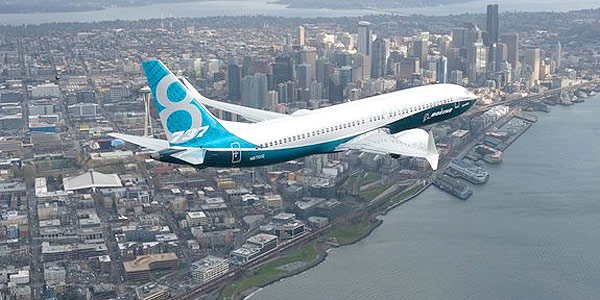|
OPINION Was the B737 MAX-8 an accident waiting to happen?The Lion Air and Ethiopian Airlines B-737 MAX-8 crashes put the spotlight on aircraft design flaws, corporate hubris, upgrades by stealth, and and a cosy certification process that failed to sound the alarm. Boeing announced a halt to production 16 December 2019. By December 2020 B737-MAX flights had quietly started with Brazil's Gol. By mid-2021 with an FAA green light the aircraft was back in most countries except for China. SEE ALSO Business Class Seat Survey | Economy Class Seat Survey | Airbus vs Boeing | Small Asian airlines | Why Boeing 737 MAX fix leaves it in a fix | Covid-19 and the return of travel JUMP TO Other columns 
B-737 MAX - buffeted by the MCAS issue and possible certification irregularities IN 1959 a French passenger plane took the aviation world by storm with its sleek design and rear-mounted twin engines. Passengers flocked to enjoy the novel Caravelle jet service as airlines raced to place orders, abandoning the crash-plagued de Havilland Comet, which had spectacularly ushered in the passenger jet era in 1952. With the BAC One-Eleven already in the air and the McDonnell Douglas DC-9 inexorably grinding through its design phase, Boeing had decided by 1960 that it urgently needed a short-haul 'feeder' jet to complement its mid-range Boeing 707-120. That's when the B-737 idea sprang to life. Send us your Feedback / Letter to the Editor While late to the party with its initial order placed in 1965 and first flight in 1967, the single aisle B-737 has gone on to become the most successful aircraft model in history, on par with the legendary twin-prop workhorse, the Dakota DC-3, and the B-747 jumbo. {Boeing isn't the only company allowed to self-certify its products. As many as 80 different companies are afforded the same privilege The B-737 has racked up a phenomenal 10,000 sales – and 4,600 more in its groaning order book, prompting the company to ramp up production to 52 aircraft a month. Yet by mid-March 2019 the B737 MAX fleet had been grounded worldwide. The fast unfolding script was unusual in that industry safety bellwether the Federal Aviation Administration was the last to act as Boeing lobbied feverishly to keep its planes in the air. Finally, as countries from Canada to China grounded their fleets, President Trump stepped in to deliver the coup de grace. The Ethiopian Airlines flight that plunged from the skies on 10 March 2019 killing all 157 on board eerily mirrored the 29 October 2018 Lion Air Java Sea crash. And it set alarm bells ringing around the world with major repercussions for the aircraft manufacturer. Confronted by a second fatal incident involving a B737 MAX 8 and riled at Boeing's suggestion that poor maintenance or pilot error may have played a crucial role, Lion Air moved to reconsider its US$22bn 200-aircraft order. Shortly after, Garuda, the Indonesian national carrier cancelled its US$4.9bn order for 49 MAX-8 jets. Has technological wizardry got in the way of human skill and judgement? The MAX-8 is an impressive plane but, as with its predecessors on the 737 line, it had niggles as it was rushed off the assembly line to compete with the Airbus A320neo. Sporting larger repositioned engines (altering the weight balance) and a naturally high angle of attack, low-power performance stuttered with a tendency to stall at slower speeds. Boeing's fix was to install an all new MCAS (Manoeuvring Characteristics Augmentation System) designed to bring an aircraft's nose down to increase speed and augment lift in low-speed situations. During the flaps-out take-off phase as the ill-fated planes banked sharply before gaining speed the MCAS would have been triggered. The MCAS is a major new addition to the 737. Incredibly, it was not highlighted to pilots many of whom, even after the Lion Air incident, were unaware of this feature or why it had been introduced despite a belated bulletin from Boeing. An American Airlines pilot union spokesman said Boeing 737-800 pilots trained for the new MAX-8 aircraft with just one hour on an iPad. Other US airlines ran a two or three-hour familiarisation on computers. Pilots were not required to undergo flight simulator hours. {The MCAS is a major new addition to the 737. Incredibly, it was not sufficiently highlighted to pilots, and some in the US simply trained on iPads In the early 1990s, two mysterious crashes in America involving a United B737-200 and a US Air B737-300 had aviation circles stumped until investigators traced it to a faulty valve that caused a rudder malfunction. Three other crashes – China Southern in 1992, a Sahara Airlines training flight in 1994, and a SilkAir flight over Indonesia in December 1997 – followed in alarmingly similar fashion. In each case the results were either inconclusive or cited pilot error or 'intent' (as in the case of SilkAir). The Singapore carrier's insurer took the matter to court in Los Angeles and Boeing eventually retracted its 'pilot suicide' claim, arriving at an out-of-court settlement. What has emerged over the years is a pattern of obfuscation by Boeing; a consistent deflection of media discussion to pilot incompetence or poor maintenance; intense political lobbying by the aircraft manufacturer (a major player in US military contracts); and a dangerously cosy relationship with the FAA. The Washington Post reports that in October 2017 Brazilian airline regulators checking the new B737 MAX-8 concluded they needed "over 60 operational changes" including having pilots familiarise themselves with the MCAS with additional supervised flight hours. At about this time the FAA published its MAX-8 pilot training guidelines where "it did not once mention the anti-stall system." This egregious lapse is easier to comprehend when one looks at the manner in which the FAA manages its certification procedure. Strapped for funds and lacking manpower as its remit grew dramatically following the September 11, 2001, terrorist attacks, the agency outsourced critical tasks and vetting. This has resulted in an absurd situation where Boeing engineers perform tests on their own aircraft while other Boeing personnel certify the models 'acting as representatives' of the FAA (all the while pressured by airline management – which pays their salaries – to speed up the process). Boeing isn't the only company allowed to self-certify its products. As many as 80 different companies are afforded the same privilege. FAA engineers expressed their disapproval of this procedure as early as in 2012. The discussion was shelved. The MAX-8 basic fuselage has not changed from the first 737s though the cigar tube has grown longer to accommodate 210 passengers at 39.52m in length. The MAX-10 will accommodate 230. The original aircraft seated 115. The larger General Electric engines on the MAX-8 necessitated a repositioning of the mounts and an elevation of the nose wheel to provide the engine housing sufficient clearance on a low-slung plane. A toxic combination of design flaws, sloppy certification, and offering aircraft safety features as optional paid add-ons - something budget carrier accountants might easily pass on - raises questions for not just the MAX-8 but other multi-generation aircraft that have outgrown their original design parameters. Passenger safety will require a muscular new approach to oversight and the swift dismantling of the nexus between the examiner and examinee. The regulatory framework must look at the integrity of new aircraft designs as well as seemingly innocuous cost savings on assembly lines that may have a multiplier effect on product performance. The US Justice Department's Boeing investigation is the first step in a longterm examination as fixes are sought. On 16 December 2019, Boeing, with 400 new parked aircraft idling since the grounding, announced a temporary halt to B737 MAX production from mid January 2020. On 23 December 2019, indefatigably stumbling Boeing CEO Dennis Muilenburg was finally fired. By early January 2020 some undisclosed compensation packages were in place for affected airlines like American. As many as 3,000 Boeing workers will be relocated to various plants. Then, in a seeming quiet miracle, early December 2020 Gol Linhas Aereas Inteligentes - one of Brazil’s biggest airlines and a huge Boeing client - started commercial operations of the B737-MAX with a service from Sao Paulo to Porto Alegre. The FAA switched on the green light for MAX services in the US mid-November 2020 though passsengers still appeared to baulk at the prospect of flying on this aircraft model. By mid-2021 the aircraft was flying again in most countries except for China, which was still holding out. Clearly, manufacturer focus must be on saving lives, not cost. Planes that fall out of the skies don't sell. Send us your Feedback / Letter to the Editor Previous Columns2019 2018 The Sleep/Service equationThe Disappearing GMEco travel: less is moreBest of the restHow to win an awardPlane truth about punctualitySweet summer sweatWho's Top Dog?Don't unpack my bagPicture perfect holidaysTale of two women, or threeSomething in the air
2017 Hello, any humans here?An Aye for an AyeTravel, the fear factorHow to turn blue seas greenPolls, planes, queuesBlockade by blockheadsShanghai, back to the futureNo lap dance aloftFriendship is a rocketWhy I really need a dateIn the ICU with Legionnaires
2016 Give Bangalore its dueRoom at the VPN?How big can be beautifulWhy it's brand on the run Premeditation and physics Samsonite in a snit Bogged down by blogsRight brain has the right stuffWho's the fairest of them all?How have you been lately?Got a Black Magic Woman The rebranding of Asia
2015 Smoke gets in your eyesThe devil beaters of Hong KongThe lure of InstafameYes, still number oneStill tripping up onlineBetter late than neverCan you read bar codes?Domo arigato misuta robotoFast and furious - 2Terminal Man – the true storyHow bad ads kill good onesA matter of time
2014 Are you kidding me?Time to face the factsThe decline of reclineArt of hitchhikingShot out of the skyLies and statisticsBottoms up for goldShanghai surpriseNow, fake festivalsWhy ghetto is goodFrequently flummoxed flyersLaughing to the exits
2013 A matter of prideSpeak and it shall be understoodLet's go phishingAsia's best travel brandsBad scrambled eggsHow to pick a happy flightThe Wild Waist aloftClicks come a clatteringBrand on the runThe unfair fares affairSafe on cloud nine?Man-eaters of Mumbai
2012 The fine art of goodbyeStay fit or fake itMore than wordsWhy hotels and pigs can’t flyTo B or not to B737Are you being hacked?Snap-happy hounds bewareDelhi daze in springtimeLet's celebrate with KittyHide your prying eyesPilot project for beginnersGreen flights of fancy?
2011 The art of arriving lateWhen life drives you pottyAirports, awards, and alarmA fright for sore eyesDry skin wet eyesBack to the Tunnel of LoveWhy fearless flyers won't flee feesMore wind in the hairTravel tremors after JapanThe case of the intact bagsEnd of the OTA-man empire?A picture says a thousand words
2010 Only Engrish spoken hereVoices in the skyA tale of three airportsWhat's in a brandA big bite of a bad AppleNow haste to the hustingsJust 400 homicides and all's wellNo sex please, we're BritishSome minor details aloftHighway to the heavensYou look radiant darlingGood info a needle in a haystack
2009 Please watch that safety drillA classic cycle folderolUtterly eggcentric behaviourThe price is rightFlashing in public is a crime[Offset] my kingdom for a horseYour cash or I'll sneezeThe greening of the worldDo broccoli need passports?Could I see your profile?Great Scott! Empty seatsTravel in an age of terror
2008 There is no free lunchAnother Night in BangkokBeatings on the beachTravelling with Teenage KidsWhither Wi-Fi at 30,000ft?Are you locked in the toilet?Charge of the Flight BrigadeAcross the UniverseBaby it's cold outsideWhy I'm dying to travelA key questionGorillas in the mist
2007 Confounding customsWhen blackmail worksBy taxi through AsiaA really cheap dateMake a meal of itTales of two teethPutting curbs on carbsDial R for rip-offThe New Math aloftWhy boutique is bestAre you terminally mad?Heavy question, ladies
2006 The secret of good sleepJust bring Pluto backA fluid situation aloftWhy Friday's the bestNothing but the truthGone in 60 secondsJust use your imaginationFree flights for allIs your travel in vein?Pet peeves and solutionsViral travellers welcomeYes it's safe to step out
2005 A passage to IndiaIt is a "brand" new AsiaThe show must go onCriminally good holidaysThe accidental touristIt's a free rideSleep tips for the roadI'll follow the sunA good pillow fightA bridge too far?World's safest spotsThe need for speed
2004 Small is beautiful, sometimesBumming around AsiaSamsonite and DelilahJust one good bookSpace, the final frontierExtreme Travel for Real MenJust grin and bare itUnfazed by phraseHoney, I Shrunk My BrainMiss World to the RescueWhen things go bumpTo catch a croc, in Hongkong
2003
NOTE: Telephone and fax numbers, e-mails, website addresses, rates and other details may change or get dated. Please check with your dealer/agent/service-provider or directly with the parties concerned. SmartTravel Asia accepts no responsibility for any inadvertent inaccuracies in this article. Links to websites are provided for the viewer's convenience. SmartTravel Asia accepts no responsibility for content on linked websites or any viruses or malicious programs that may reside therein. Linked website content is neither vetted nor endorsed by SmartTravelAsia. Please read our Terms & Conditions. |






